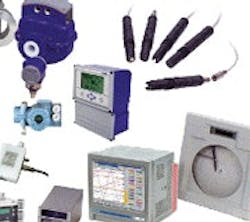Power Over Ethernet Continues Its Climb Into Acceptance and Higher Power
By Mike Bacidore, Managing Editor
Powering field devices such as sensors or controllers has been one of the interesting puzzles posed to plant engineers and network developers. And then, along came power over Ethernet (PoE).
While standardization by IEEE has helped to drive acceptance and create interoperability, the non-standard proprietary innovations have continued to push it to its full potential, whether industrial applications need it or not.
PoE is being used mostly in robotics and some machine applications where routing any cable is a problem and in vibration-prone applications in machines, says Doug Erlemann, business development manager-cameras for Baumer Group (www.baumergroup.com). "One less cable is worth the slightly higher cost of the PoE system," he says.
While most recognize the technology, PoE is still rarely put to good use in the industrial space, says Eric Juillerat, president and CEO of Raven Technology Group (www.raventechllc.com) "Ethernet has been fully accepted as a networking bus, but it remains clouded by decades of antiquated in-place instrumentation and proprietary manufacturer buses, despite the massive availability of Ethernet infrastructure solutions."
IEEE's PoE standard defines the power sourcing equipment (PSE) and the powered device (PD) that are used. The PSE is a separate device typically installed in the wiring closet near the Ethernet switch or hub, explains Gerard Nadeau, PoE consortium manager at University of New Hampshire InterOperability Lab (www.iol.unh.edu) in Durham, N.H. The PSE inserts dc voltage onto the twisted pair cable and can be either an endpoint or a midspan device. An endpoint PSE is one that contains both the data communication capabilities and the power-delivery mechanism. A midspan only contains the power delivery mechanism and is inserted in the network between the legacy, non-PoE-capable Ethernet switch and the PD, explains Nadeau. The midspan provides the ability to add PoE to the network without replacing the existing infrastructure.
The PSE chooses which mode and class of service, or power level, it supports, explains Art Felgate, product manager, Transition Networks (www.transition.com). "A PSE can support only Class 1 and Class 2 in Mode A, for example, and still be compliant with the IEEE 802.3af standard," he explains. Class 1 requires at least 4 W of power, while Class 2 requires 7 W. "If an attached PD required greater power than Class 2, this solution wouldn't work, even though both the PSE and PD in this case are IEEE 802.3af-compliant."
Classification of PDs should improve, adds Felgate. "Currently, many PDs simply indicate Class 0 compliance—full power, up to 13 W—whether or not they actually draw that much current," he says. "Many PSEs can make intelligent decisions about managing their pool of power if they have more accurate PD power information. By providing a more accurate power signature during the PoE classification stage, PDs can contribute to more efficient use of network resources, especially power supplies."
Daisy-chaining is allowed by PoE, explains Daniel Feldman, PoE/PoE+ subcommittee technical chair of the Ethernet Alliance (www.ethernetalliance.org) and director of marketing for Microsemi (www.microsemi.com). "One could build a system that receives and then forwards power to another device, which receives power and forwards power and so on," he says. "Practically speaking, one could daisy-chain four devices, extending the range of an Ethernet cable up to 1,200 ft—four devices at 300 ft of cable each."
EtherCat uses only midspan power sources, connected via Cat. 5 cable directly to the power over EtherCat device, explains Joey Stubbs, PE, PMP, North American representative, EtherCat Technology Group (www.ethercat.org). "These devices have only one connector, which prevents the cascading or daisy-chaining of additional devices to the network, so as not to exceed the 802.3af current and power limitations," he says.
Midspan devices can be used to overcome switch limitations, including non-support of PoE or non-support of the maximum power requirement of the end device, explains Paul Brooks, business development manager, networks portfolio, Rockwell Automation (www.rockwellautomation.com). "Users should consider the function midspan devices perform and understand they aren't required to be located near the switch," he says.
As some manufacturers deviate from IEEE standards and seek new ways to raise the limits of power delivered over Ethernet, caution and application ultimately will set the bar.
Interoperability, as with all technology, is a concern for PoE, especially with proprietary midspans that support 1000Base-T connections, which aren't compliant with the IEEE standards.
Some vendors are making proprietary midspans that support 1000BaseT, but since the designs aren't standardized, this could lead to the kinds of interoperability problems that Ethernet solved long ago, explains Nadeau.
"Being that they are not standards-compliant, there is a risk they will not work with equipment designed to meet the forthcoming POE Plus standard," says Felgate.
Relying on IEEE 802.3 standards is advantageous and ensures that PoE devices are not vendor-specific, says Stubbs. "It prevents a user from being locked into proprietary, expensive solutions from a single vendor," he explains.
Nadeau agrees that the IEEE standard provides a greater potential for interoperability between vendors, but notes that peace of mind creates limitations. "The disadvantage of being IEEE-compliant is that you might not be able to squeeze all the power out of the system and you are only allowed to power on one pair set at a time," says Nadeau. "Proprietary systems tend to push the limit and could power multiple pair sets at one time." However, this could cause interoperability problems and potential safety issues, he warns.
Due to the current large installed base of IEEE 802.3af solutions, manufacturers have an incentive to maintain compliance, notes Felgate. "The disadvantage of relying only upon the standard is this may stifle adoption of some of the more interesting variations and uses of PoE," he argues. "If an organization has a compelling need or requirement to deviate from the standards, it should just be fully aware of any risks that might entail."

